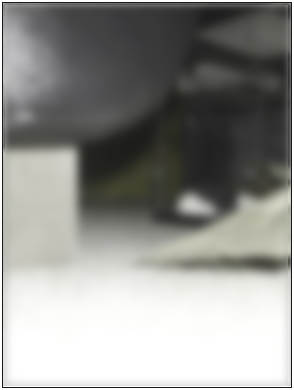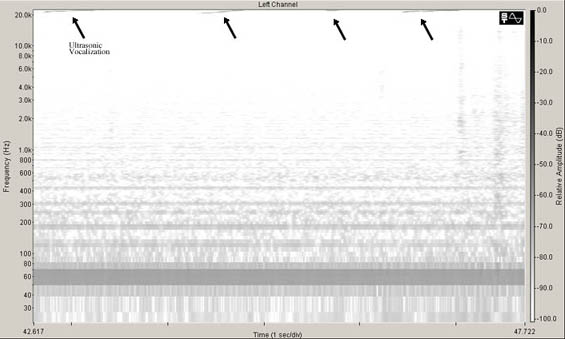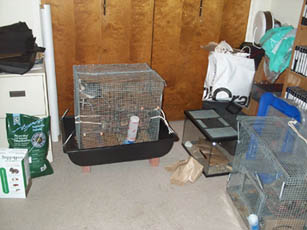The sensory systems of the rat are different from our own. The way a rat perceives the world is therefore going to be radically different from how we perceive the same scene. The animal's perception of its surrounding world is called its ümvelt. What is the rat's ümvelt like?
|
|
|
How does the rat perceive his world? |
In every other domain, however, the rat's senses are far more sensitive than our own!
A rat perceives its immediate environment with its whiskers, through its sense of touch. The rat whisks its whiskers back and forth dozens of times per second, brushing them against the floor, objects, walls, other rats. The rat gains a highly detailed picture from this tactile exploration: the rat's whiskers are more sensitive than our own fingertips.
The rat lives in a rich, complex world of smell. We can hardly imagine what such a world is like, our sense of smell is so impoverished. But every surface, every object, every whiff of air, contains different smells and information for a rat.
A rat's hearing is more sensitive than our own, it picks up softer sounds than we can and detects much higher frequencies, into the range of ultrasound.
Lastly, not only is the rat's sensory perception different from our own, but the features of the environment that the rat notices and considers important are going to be very different from the features we notice and consider important. The way the rat interacts with the environment will be different too. When we look into a room, we see chairs to sit on, desks and tables to write and type and eat on, beds to lie on, monitors to watch and keyboards to touch. To a rat, a room offers hiding places under filing cabinets and bed frames; attractive runs along floor edges; climbing spots up bookcases, chair legs, and beds; books to chew; fabric to shred for bedding; small items of food to eat; and vast new places to explore on top of desks and tables.
Vision
Contrary to the popular view of rats as totally colorblind, rats can distinguish some colors. While humans have three kinds of color sensitive cells (blue, green, and red), rats have just two types -- a blue and a green -- somewhat like humans with red-insensitive colorblindness. That isn't all, though. The rat's "blue" cones are shifted toward the ultraviolet, a part of the spectrum we humans can't see. So rat vision is dichromatic but includes shades we cannot see in the ultraviolet range.
So rats can distinguish ultraviolets, blues, and greens, but they can't see reds. Rats also have a "neutral" point in the blue-green area of the color spectrum which might look white to them, and they cannot distinguish some blue-greens from certain shades of gray. Here's what the world might look like to someone with red-insensitive colorblindness:
|
|
|
|
normal human vision |
red-insensitive colorblind |
|
|
|
red-insensitive colorblind, faint color |
Rats have the physical capacity to distinguish between greens, blues, and ultraviolets, and behavior experiments
have demonstrated that they can be trained to distinguish between these colors. However, under normal circumstances
rats do not appear to attend to color differences, focusing instead on brightness cues.
|
|
|
|
|
Normally-pigmented rats have blurry dichromatic vision with low color saturation |
Albino rats may see a very blurry, light-flooded world |
On a bright day, albino rats may be completely dazzled |
Albino rats have unpigmented irises that do not block light well, so their retinas are constantly dazzled with light, leading to retinal degeneration. Hence, the visual acuity of albinos is much worse than normally pigmented rats, around 20/1200. An albino rat may live in a world of shifting, undefined patches of dark and light.
Ultimately, rats probably use their vision to detect large, moving, distant objects and to orient themselves in space. At close range, rats rely on other senses: whisker touch and smell.
For more images of the world through a rat's eyes, visit the Rat Cam page.
Perspective
A rat isn't going to see the world from the same angle we do: rats aren't five feet tall, their eyes are only an inch from the ground! And more than that, what is important to the rat is going to be different from what is important to the human: a pet rat lives in a world of hiding places, runways, small food items, tiny objects, shreddable fabrics and paper, chewable surfaces, and sheer looming cliffs of furniture.
To get an idea of how a rat sees the world, get down on your hands and knees and peer around from floor level. Pretend you're only three inches tall. You'll be amazed at the things you see: hiding places under furniture, narrow triangular openings between books on the bottom shelf of a bookcase, a bent paper clip and two staples and a twist tie, a fragment of paper, a little lint, an inviting tunnel under a jacket, a long thin pen.
|
|
|
View of rat cages from a human perspective |
Rat's eye view of the cage from the floor (dichromatic, low saturation, blurry).
You can see the nice hiding place under the cage tray between the bricks, and the crack below the closet door which is probably full of interesting smells.
Rats like to run along the edges of rooms, because the vertical wall protects them from that side, it helps them navigate by whisker touch and familiarity, and it may indicate nearby shelter. In this image you can see an attractive floor edge behind the cage -- an inviting rat runway.
Rat's eye view of the left corner of the cage (dichromatic, low saturation, blurry).
This area is cluttered with large, sheltering objects, so it is more attractive than the wide open, exposed floor. You can see several good hiding places from here: under the cage, between and behind the boxes of pet bedding.
Rat's eye view, looking up at the cage from below the front right corner (dichromatic, low saturation, blurry).
You can just make out Cricket's head way up high on the top shelf.
Touch
A rat perceives its immediate surroundings through its whiskers: long, sensitive hairs growing from the rat's cheeks, eyebrows, and chin, more sensitive than our fingertips. They rapidly whisk back and forth, brushing everything close to the rat, detecting every tiny detail and irregularity. The rat lives in a world of textures. He can navigate largely by touch.
For an idea of what this might be like, get down on the floor, close your eyes and lightly run your fingertips along the floor. Feel the texture of the floor. If you have carpet, feel its fibrous, springy texture. Your fingertips may find higher tufts of carpet, specks of debris, a small stiff spot from a tiny spill. You may find indentations in the carpet where heavy objects were placed. You may find that areas where you walk are flatter than the edges of the room. If you have hardwood floors, feel swirls of the wood, the slight ridges where the boards join, a constellation of tiny specks of debris. Along the edges of the room you'll find the wall, a sheer, smooth cliff face. Feel the bottom of the wall, the dings and bumps and chips, the faint strokes of paintbrush, the tiny lifted edges of wallpaper.
This is the rat's landscape. What the rat lacks in vision, he makes up in touch; he runs through a rich, complex world of braille. Here are some of the textures a rat might perceive:

So, while the world may look blurry to the rat...
... his whiskers will provide detailed information about what he can touch as he moves through the landscape.
The rat's whiskers can't detect objects at long range, of course, like our eyes do. Whiskers are short-range, detecting objects and surfaces just a few inches away. As the rat moves through the landscape, objects more than a few body lengths away will be blurry and vague, seen only through his eyes. His close surroundings, however, will be extremely sharp and detailed thanks to his whiskers.
Smell
A rat lives in a galaxy of smells. Every object, every surface, every breath of air contains different smells and information for a rat. His nose is unbelievably sensitive. Over 1% of his DNA is devoted to detecting odors, an incredibly high percentage that gives us some inkling of how critical smell is to him.
We can barely dream of what the rat's scent-filled world is like. To get a faint idea, get down on the floor, get your nose real close to the ground, and smell the different surfaces available to the rat (I'm not kidding!). We don't have the words to describe the immense variety of what you'll discover with your nose on your own floor: the smell of carpet, book cover, door edge, and clothing, the odor of wallpaper, shoes, metal bed stand and electrical wire. Their smells are as varied as their colors and their textures, but we can barely detect them and cannot name them. Yet this is the perceptual world the rats live in, an enormous, rich world we can only faintly detect.
What might a rat smell in a room?
Sometimes you'll see a rat stop and press his nose into a surface, sniffing deeply. He is using his second scent organ, the vomeronasal organ, to pick up large odor molecules left by other animals, such as scent marks. The tiny drops of urine a rat leaves behind when it scent-marks are chock full of information about the rat who produced it: the rat's sex, sexual maturity, reproductive status, sexual availability, social status, individual identity, and current stress level. Urine is a veritable window onto another rat's inner state (and here we thought the eyes were the window onto the soul!). With a black light we can see the landscape of scent marks that a rat detects by smell:
Photograph of a cage shelf under normal light (left) and ultraviolet light (right). The rats' urine marks, faintly visible under normal lighting conditions, glow under the black light.
Hearing
A rat's hearing is more sensitive than our own, rats can hear softer sounds than we can and can hear up into the range of ultrasound. To give you an idea, humans can hear up to 20 kHz, but rats can hear up to 90 kHz!
Rats therefore hear more environmental noise. The humming of overhead lamps, of electrical wires in the wall and on the floor, of a computer monitor, all fall within a rat's audible range. Distant traffic and airplanes, faraway birds, kitchen appliances in neighboring houses, are all theoretically audible to rats. The crinkling of a plastic bag, so distressing to rats, includes loud, unpleasant ultrasounds. Outside, rats can hear the ultrasonic chirps of hunting bats. Rats perceive far more sound in our shared environment than we do.
A great deal of rat communication happens above our range of hearing. Infant rats emit distress calls between 30-50 kHz, when they are cold or when they are stepped on by their mother. Adult rats emit long, 20 kHz squeaks when they are stressed -- when they are defeated socially, see a predator, or experience pain. These distress vocalizations are just barely audible to a human with a sharp ear. Rats also emit short, high pitched calls (around 50 kHz) in positive contexts -- during rough and tumble play, courtship, and in anticipation of feeding. So rats communicate with each other on a whole different channel from what we can hear with our own ears.

Sonogram of a rat making long, 20 kHz distress vocalizations (the faint nearly horizontal lines at the very top of the image). Two rats were standing face to face, nose to nose. The instigator was sidling slowly toward the defending rat, who was cornered and had his mouth slightly open. To me, the rats seemed silent. In their range of hearing, however, the defending rat was emitting constant, high pitched, distressed squeaks.
If you enjoyed this article and would like to read more, visit:
- The rat's sensory world for articles about the rats' senses and supporting references.
Methodological notes: to approximate red-green colorblindness I used Photoshop. I changed the red channel to solid black, then copied and pasted the green channel into the red channel. To mimic the rat's faint perception of color, I reduced the color saturation of the image down to a just noticeable level (-70%). To mimic the rat's blurry vision, I applied a Gaussian blur. For the small water lily images, I applied a blur of 3 pixels (I have 20/600 vision myself, so I tried to match the amount of blur to what I see without corrective lenses). To simulate the albino rat, I doubled the blur. I increased the lightness by 30% and the brightness to 50% to simulate light flooding through the iris and dazzling of the retina.
In the sonogram of the ultrasonic vocalizations, I slightly darkened the vocalizations to make them more visible.






